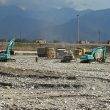In the heart of eastern Bhutan, a quiet agricultural revolution is taking root, and maize is leading the charge. Once a symbol of subsistence, the humble maize crop is now emerging as a surprising source of prosperity for many in Monggar.
Among those who’ve embraced this golden opportunity is 46-year-old Dechen Norbu of Chali. Once a truck driver navigating Bhutan’s rugged terrain, Dechen now finds himself navigating a very different kind of journey—one that begins in the fields and ends in profit.
“I used to spend days away from home as a trucker,” said Dechen, who now rents an acre of land beside the Monggar highway with his wife. “Now I get to work with my wife, grow maize, roast it, and sell it. On average, we make over Nu 2,000 a day. Just yesterday, we made more than Nu 8,000. It’s hard work, but it pays better than driving.”
Dechen is part of a growing number of individuals who are trading in city jobs or labor-intensive professions to return to the land—and thrive. Together with his wife, he sells freshly roasted maize cobs and packaged beaten maize to eager passersby. Their roadside stall is one of many that have sprung up along the highway, where just a few years ago, only four maize vendors operated. Today, that number has nearly tripled.
Not far from Dechen’s stall, Pem Dorji and his wife Tshering Choden are reaping the rewards of their own maize enterprise. Farming over two acres of rented land, the couple works in tandem—Pem harvesting and Tshering roasting and shelling the maize in a makeshift hut near the fields.
“We roasted two tins of maize in just an hour this morning,” Tshering said, her hands busy beating roasted kernels alongside Dechen. “Last year, we made over Nu 300,000. This year, we’ve already earned more than Nu 200,000, and the season’s not over yet.”
Though the work is physically demanding and the farmers face threats from wild boars and occasional pests, the rewards are substantial. “We’ve been lucky so far,” said Pem. “Even the monkeys have stayed away.”
The maize season lasts just a month, after which most farmers transition to paddy cultivation. But in that short time, many are making what used to take months or even years to earn.
The transformation unfolding in Monggar is more than an agricultural success story—it’s a shift in livelihood, identity, and opportunity. For families like Dechen’s and Pem’s, maize is no longer just food on the table. It’s become the foundation of a better life.
As more vendors set up shop along the highway and more hands return to till the soil, Monggar’s once-humble crop is turning into the region’s golden ticket.








